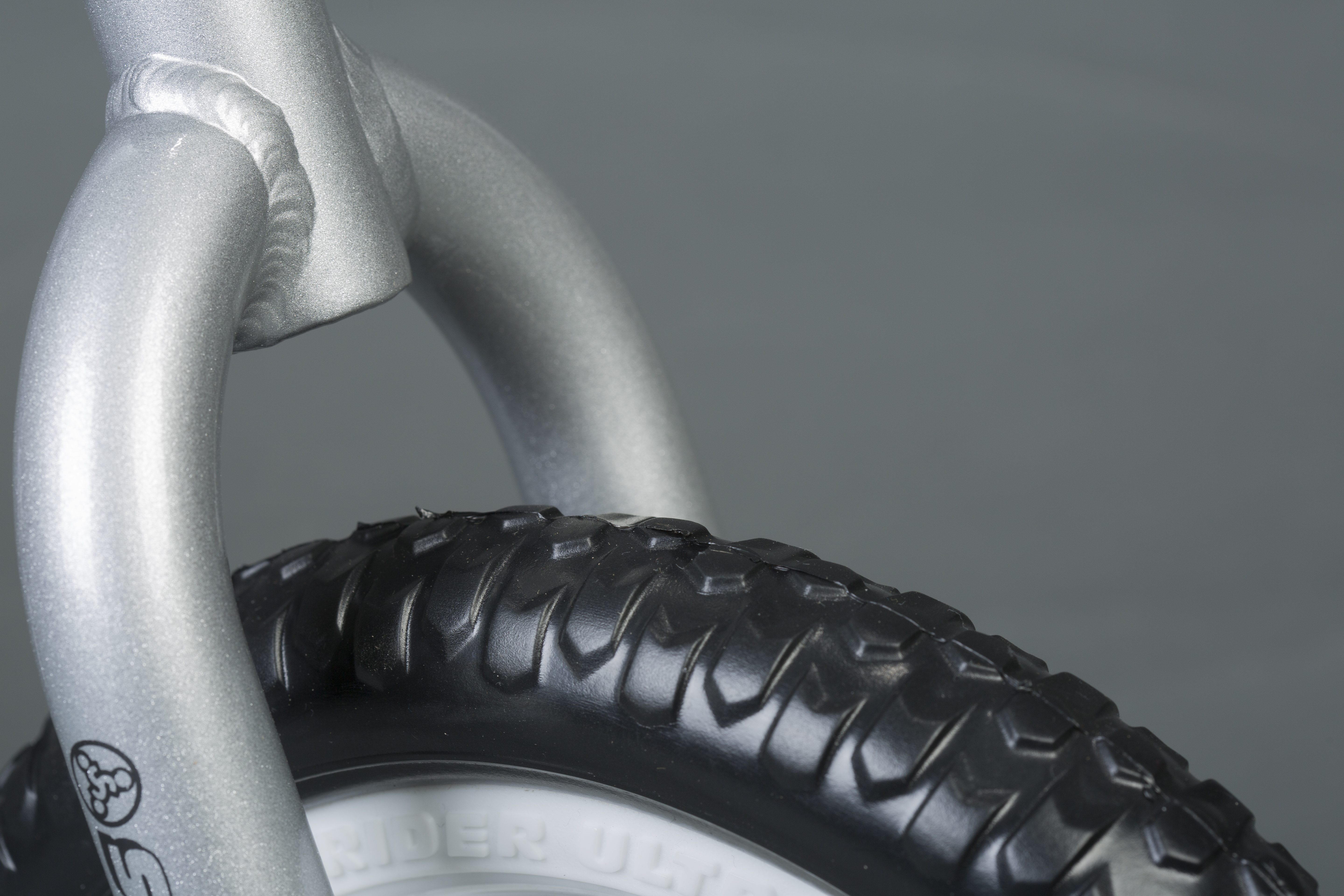Strider 12" Pro balance bike review
Giving your child a good first experience on a bike is important if you want them to grow up and love their bikes as much as you do. A balance bike is the ideal introduction and avoids the difficult transition from stabilisers to two wheels. We tested the Strider 12" Pro balance bike, with a sometimes willing, and sometimes not so willing toddler

At £80 the Strider is quite pricy. There are cheaper balance bikes on the market, but do bear in mind the weight. The heaviest ones can come in around 5kg, around half the weight of an average toddler. Imagine trying to pick that up or manoeuvre it round a tight bend or past a climbing frame every 20 seconds or so.
-
+
Lightweight so easy for a small toddler to handle
-
+
Lots of adjustment meaning it can last for years
-
+
Solid tyres so no messing with pumping them up or mending punctures
-
+
Easy to build
-
-
Expensive for a toddler
-
-
When saddle at lowest setting seatpin sticks out the bottom which can catch ankles
-
-
More colourful options might be attractive to kids
You can trust Cycling Weekly.

I still remember the day my stabilisers came off. I don’t remember exactly how old I was, but I remember what happened. I was riding down the pavement, not getting very far before losing my balance and jumping off the bike as it rolled into the gutter between two parked cars. I ran off in shock leaving my mum to pick the bike up. I don’t know why, but I’d been scared of using my brakes. I was concentrating so hard on my balance and pedalling that steering and braking became too much for my brain to process.
Buy now: Strider 12" Pro balance bike at Strider bikes for £110
Some might say that my bike handling skills haven’t improved all that much, and while I beg to differ, it clearly wasn’t the best start to my cycling career.
The transition when taking off a child’s stabilisers is a big one. It presents them with an entirely different skill to try and master. You steer a bike by leaning, whereas stabilisers turn a bike in to a trike, completely changing the way you steer. Neither do stabilisers teach a child to balance – that’s where balance bikes come in. If only I’d had one. I could have been a contender.
>>> Best kids' bikes 2019: top tips for choosing a children's bike
For a child, learning to balance is far more important than learning to pedal. Pedalling is just propulsion and isn’t entirely necessary, whereas balance is.
Balance bikes allow a child to learn to balance and steer while having their feet in contact with the ground. Propulsion comes from scooting along with their feet, as does a sense of security. They’re wobbling all the time, but with their feet in contact with the ground they’re constantly righting themselves. As they do they’re learning how to lean the bike to steer in the direction they want to go. Which is exactly what we do. Just with more Lycra.
The latest race content, interviews, features, reviews and expert buying guides, direct to your inbox!
Scooting with feet is also a speed limiter. Avoid big descents (as any responsible parent would) and their speed will only be a little higher than their fastest running speed.
By learning the key skills of balance and steering straight from the get-go, progressing to pedals is a cinch. There’s no change in feel of the ride and as the act of pedaling is so simple kids tend to be up and running in minutes when progressing to pedals.
There are lots of balance bikes available from Frog to Hoy, Islabikes and more. We tested the Strider as at 2.4kg it’s one of the lightest on the market. This is an important factor, probably more so than it is for your most obsessive weight weenie.
Learning to ride a balance bike will involve lots falling off, stepping off and picking it back up again. If it’s too heavy, a toddler can quickly lose interest, and that’s something we really don’t want to happen.

The low weight of the Strider doesn’t come with any durability issues. The frame and forks are sturdy aluminum with solid welds and chunky dropouts. These bikes take a lot of abuse, so they need to be up to the job.
The wheels are solid plastic but only weigh 442 grams each (including axle and tyre) and come with sealed bearings. Mounted on each wheel is a solid tyre. Genius. We can save the puncture repairing lessons for later in life.
Each wheel is tightened with 14mm nuts and has the added benefit of a teardrop-shaped washer with its point bent through 45 degrees. That sits in a hole in the frame behind the dropout. Should the nut come loose, the wheel isn’t going anywhere.
Moving forward from the rear wheel you have a little footplate sat on top of the chainstays just behind the bottom bracket. When the toddler gets tired they can rest their feet on here allowing mum and dad to push them along. Just mind your lower back. It can also be used to get feet out of the way on gradual descents, or even for standing up and coasting when they’re a little more proficient.

Underneath that is a brake mount for a foot-operated brake. This addition is advised only when the child is proficient at gliding. Slowing down using both feet on the ground is the best option when starting out.
Moving forward up the main tube there’s a very simple headset. Basically plastic washers running on each other. They’re not going to take hours and hours of hits from rough tarmac, ridden in bad conditions, or jet-washed, so there’s no need for anything more.
The Strider handlebars are an aluminium T-bar with around eight centimetres of vertical adjustment via a quick release. The 7cm grips either side of the padding give a 34.5cm wide bar. Measured from the outside edge of one grip to the other. The rubber discs at the end prevent hands from slipping off.

All in all it’s a good package, well put together, easy to maintain and build straight out of the box. The build took just a few minutes, important if given as a present.
Getting the right size is really simple with the quick-release skewer on the seatpin giving a range of five inches. This may not seem a lot but can be 50 per cent of a toddler’s inside leg measurement. My daughter was a little too short at the age of one even with the saddle at the lowest setting, but she was in the 10th percentile for size so that wasn’t too surprising. She still wanted to sit on it, she just couldn’t propel herself as it was only her toes reaching the floor. Instead she’d sit on it and we’d push her around.
That range, and the adjustment on the handlebars means the Strider will last for a good two years for most toddlers. More in some cases. Just keep an eye on their feet as they use it. They should be perched on the saddle (not sat with all their weight on it) pushing themselves along with their feet more or less flat on the ground, or with their heels just off depending on proficiency. Keep the saddle adjusted accordingly.
Buy now: Strider 12" Pro balance bike at Strider bikes for £110
Getting toddlers to ride
For my daughter, and for other parents in the CW office, it was a case of leaving the Strider around the house and garden so it can be picked up and used as and when they wanted.
Taking it with you when going to the park or days out is a good idea and easy to do with a bike as light as the Strider. This is the preferred option as going on specific trips to ride it is a waste of time. The chances are they wouldn’t want to, just because you do. Allow them to get used to it first, when they’re enjoying it they’ll ask to use it.

Editor of Cycling Weekly magazine, Simon has been working at the title since 2001. He first fell in love with cycling in 1989 when watching the Tour de France on Channel 4, started racing in 1995 and in 2000 he spent one season racing in Belgium. During his time at CW (and Cycle Sport magazine) he has written product reviews, fitness features, pro interviews, race coverage and news. He has covered the Tour de France more times than he can remember along with the 2008 and 2012 Olympic Games and many other international and UK domestic races. He became the 134-year-old magazine's 13th editor in 2015 and can still be seen riding bikes around the lanes of Surrey, Sussex and Kent. Albeit a bit slower than before.